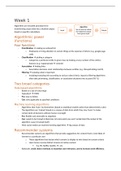Summary
Summary for 'Algorithmic persuasion' and its readings - exam grade: 8.8
- Course
- Institution
This contains the summary of the gazilion readings for UvA course 'Algorithmic persuasion' and notes. Readings a.o. include those of Boerman, Zarouali, Matz, Segijn, etc. Everything is organized according to weeks (W1-8), with headers and subheaders. Exam grade: 8.8
[Show more]



